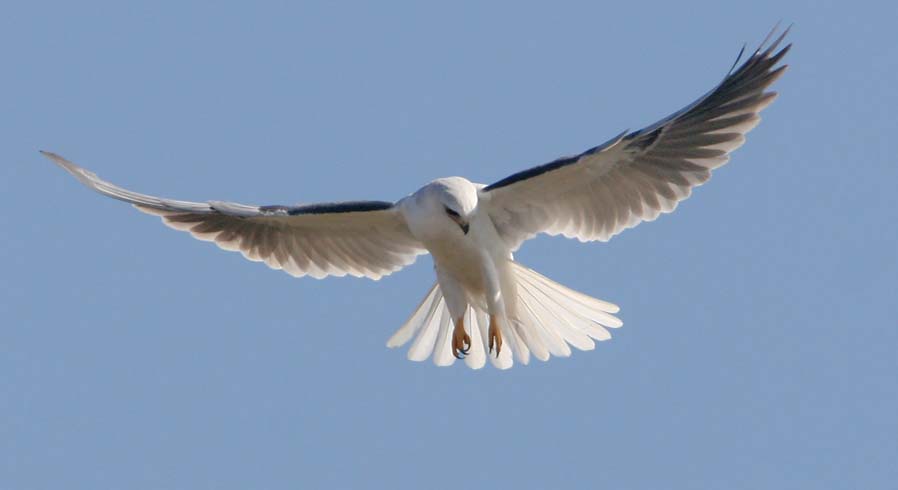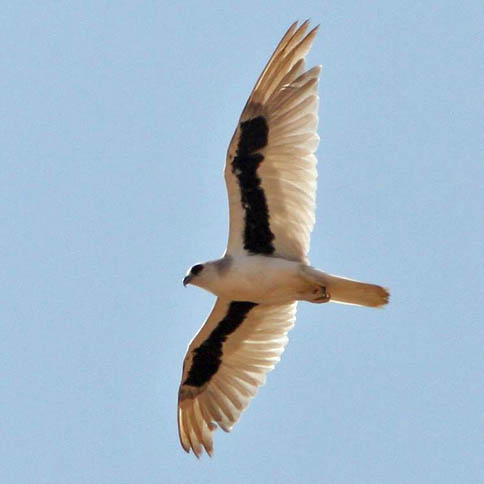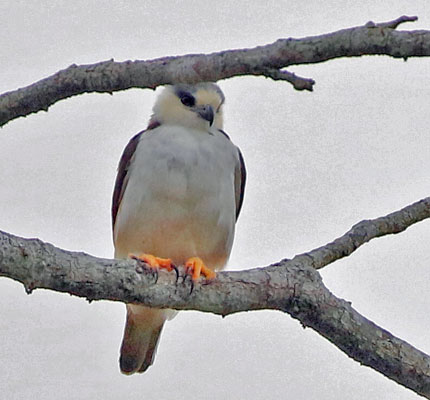
a web page by Don Roberson |
ELANIN KITES Elanidae |
|
Four of the 6 species in the Elanidae are kites in genus Elanus. These are found around the globe, in all continents except Antarctica. The widespread New World bird is White-tailed Kite (left, in juvenal plumage, and an adult, below). |
 |
The four kites in genus Elanus are gray-and-white raptors on open country distributed across all the major continents. There are distinctive black patches on the wings of each species. They quarter low over grasslands in search of small rodents, and are beautiful in flight. Black-winged Kite E. caeruleus is a widespread species of open country in Europe, Africa, and tropical Asia. Black-shouldered Kite E. axillaris occurs throughout Australia. Much more local and the most nocturnal of of the genus, Letter-winged Kite is a rare bird primarily confined to the arid outback of Australia (right). |
Pearl Kite (left) is a very small kite — smaller than a kestrel — that resides in the tropical lowlands of South and Central America. It often hunts from bare trees or telephone wires. It is thus a small, falcon-like predator but, genetically, is a part of the Elanin kites. Yet it is so different that other members of this Family that Starikov & Wink (2020) proposed a new subfamily just for it (Gampsonychinae). Pearl Kites feed on small lizards and insects, and generally inhabit drier habitats, including savanna, open woodlands, and pastures, but also the edges of lowland forests. There are almost 30 raptors in 18 genera that are called "kites," including the 6 in this new family. These rest of the "kites" are not a natural groups but an assortment of mid-sized hawks, some of which excel at 'kiting" — effortlessly soaring and gliding in thermals in search of food. Widespread hawks like Black Kite Milvus migrans in the Old World, or Snail Kite Rostrhamus sociabilis in the New World, are not related to Elanin kites or to each other. Yet, if we think only in terms of Bird Families, we can use "the Kite family" as shorthand for this closely-related set of kites. |
Most encounters with these kites around the world have been brief, but I do enjoy my interactions of our local White-tailed Kites. They are graceful and gorgeous for a raptor, and their ability to hover and pounce of prey with keen eyesight is amazing. It was once considered rare in California — and just one of five raptors that had full legal protection in the State before 1960. We now know that it has a "boom-or-bust" population cycle, closely tied to the population of voles and mice. Where I live, that prey is California Vole Microtus californicus (Roberson & Tenney 1993, Warner & Rudd 1975). |
Photos: The young White-tailed Kite Elanus leucurus was at Pebble Beach, Monterey Co., California, on 27 Oct 2021; the hovering about was also in Pebble Beach, on 7 Feb 2008. The Letter-winged Kite Elanus scriptus was along the Birdsville Track, South Australia, on 20 Nov 2009. The Pearl Kite Gampsonyx swainsonii was in the Darién region of eastern Panama on 14 Feb 2022. All photos © Don Roberson; all rights reserved. Bibliographic note: There is no "family book" per se, but a fine introductions to these kites are in Brown & Amadon (1968) and Thiollay (1994). Literature cited:
|
 The Elanin Kites, or just "Kites," are the kites that have traditionally formed the subfamily Elaninae. This group has long been considered one of the traditional subfamilies of family Accipitridae (Hawks & Eagles). Now, Starikov & Wink( 2020) found evidence that this group diverged about 21 mya (million years ago), and therefore "the molecular phylogeny of Elanin kites based on mitochondrial and nuclear markers confirms their position as sister taxa to other Accipitridae, and together with morphological, cytogenetic, and ecological data, lead to separating them in the family Elanidae." Osprey (Pandionidae) has been split from Hawks & Eagles for many years; this proposal, if accepted, would slice 6 more species from 3 genera from the Accipitridae to form this new family. To date, among the major world checklists, only Birdlife International has elevated the Elanidae, but the proposal has merit.
The Elanin Kites, or just "Kites," are the kites that have traditionally formed the subfamily Elaninae. This group has long been considered one of the traditional subfamilies of family Accipitridae (Hawks & Eagles). Now, Starikov & Wink( 2020) found evidence that this group diverged about 21 mya (million years ago), and therefore "the molecular phylogeny of Elanin kites based on mitochondrial and nuclear markers confirms their position as sister taxa to other Accipitridae, and together with morphological, cytogenetic, and ecological data, lead to separating them in the family Elanidae." Osprey (Pandionidae) has been split from Hawks & Eagles for many years; this proposal, if accepted, would slice 6 more species from 3 genera from the Accipitridae to form this new family. To date, among the major world checklists, only Birdlife International has elevated the Elanidae, but the proposal has merit. These Elanus kites are known for the ability to hover in search of small mammal prey, and they have more owl-like features than other diurnal birds of prey, include large frontally-placed eyes, zygodactylism (
These Elanus kites are known for the ability to hover in search of small mammal prey, and they have more owl-like features than other diurnal birds of prey, include large frontally-placed eyes, zygodactylism ( Scissor-tailed Kite Chelictinia riocourtii is a graceful kite of the Sahel region of African, the arid grasslands south of the Sahara. It uses communal roosts, and is the one Elanin kite I've not seen.
Scissor-tailed Kite Chelictinia riocourtii is a graceful kite of the Sahel region of African, the arid grasslands south of the Sahara. It uses communal roosts, and is the one Elanin kite I've not seen.